Mystery solved? Not quite. I made a test coupon of the output transmission line and measured it. Over the crossover region, it showed a mere 0.04 dB loss with increasing frequency, much less than the measured result. I turned my attention back to the input network. The design simulations did not account for parasitic capacitance in the high-valued resistors. In some cases, parasitics can be disregarded by accounting for them when chosing an explicit compensation capacitor. In other cases, particularly Rα2 in the following section’s schematic and the BUF802 input bias resistor (10 MΩ, not shown in the basic schematic), there is no frequency compensation in the design. For a 0402 package, a reasonable estimate of parasitic capacitance including the pads and PCB is 50–100 fF. At these resistances, the pole frequency will be in the middle of the crossover region. Including this in the circuit simulation of the input yielded almost the exact peaking response seen in the probe.
To reduce the parasitic capacitance, an obvious move is to split a large resistor into a series combination. Diminishing returns set in quickly as other parasitics are introduced by increasing parts count. Some more testing is needed to see if this yields a practical improvement for the last 3–4% of flatness in this region.
Design overview
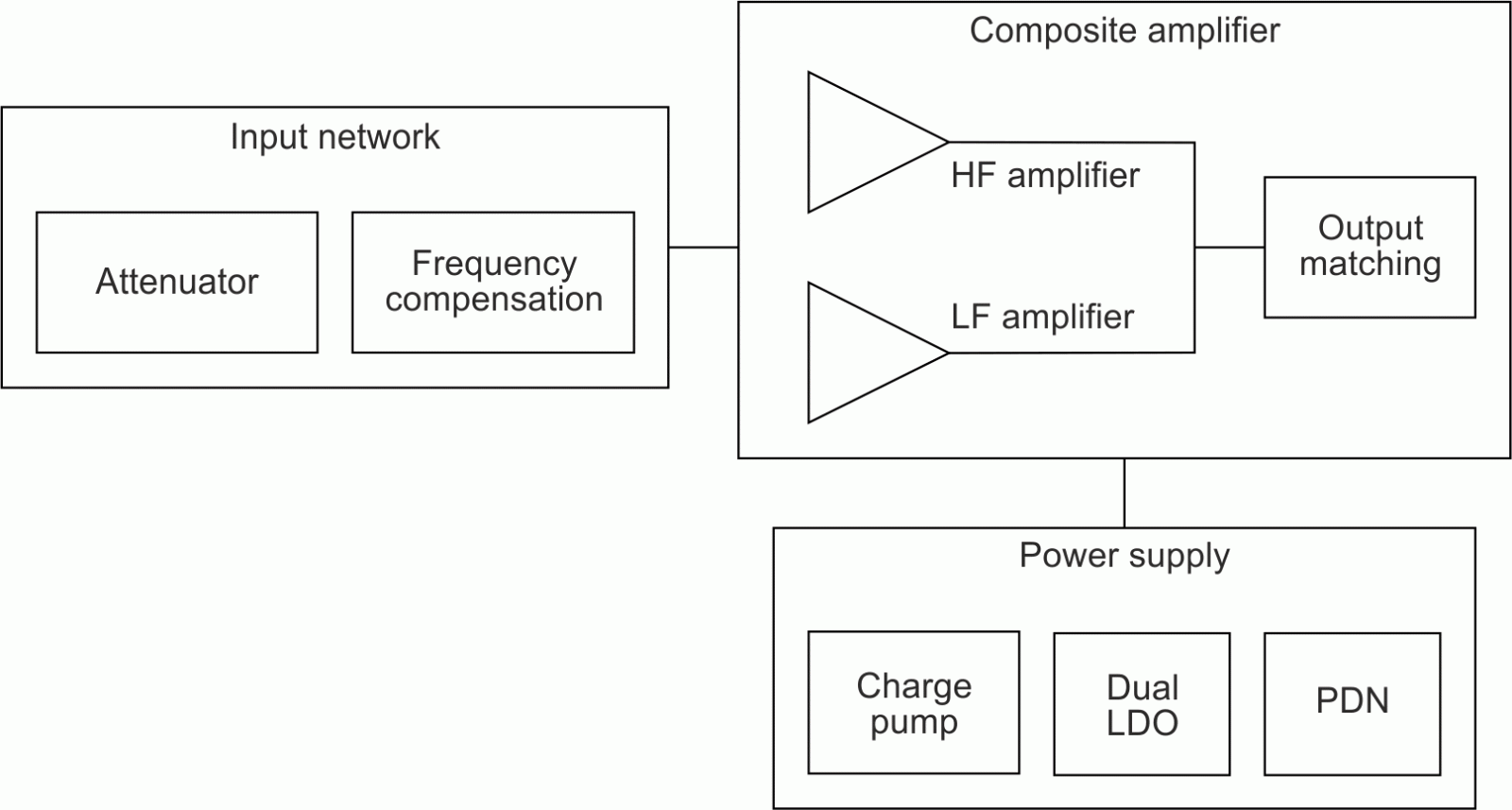 |
|
| Figure 12. | High-level block diagram of the probe design. |
The active probe has three main components in this overview block diagram (Figure 12). An input network is responsible for passive attenuation and frequency compensation. The amplifier block contains the low- and high-frequency amplifiers that work together to provide a flat, wideband response, and an output matching network including the transmission line to the output connector. The power supply block uses a charge pump and dual low-dropout (LDO) voltage regulator to supply positive and negative DC voltage to the amplifier.
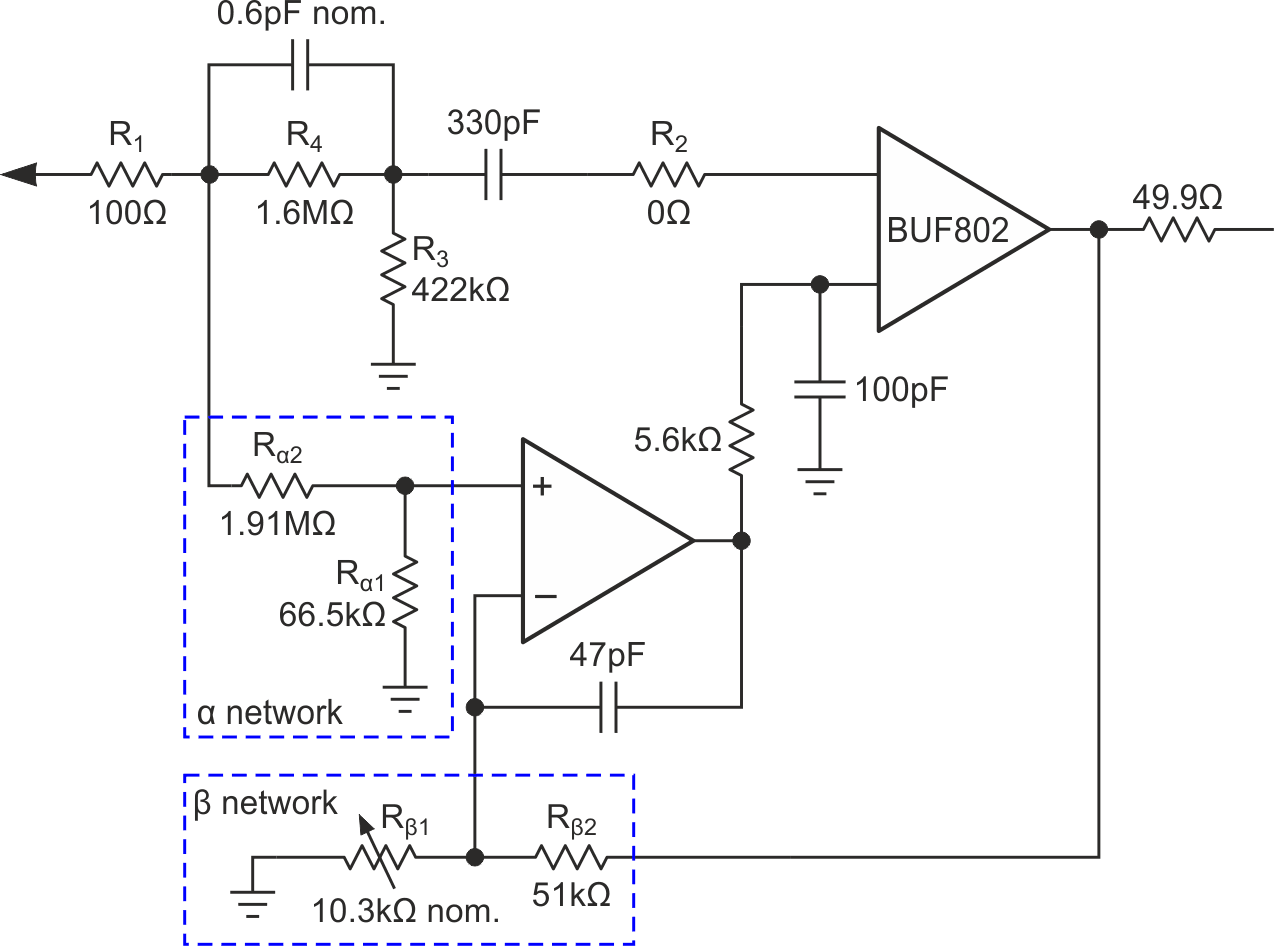 |
|
| Figure 13. | Simplified schematic of the probe input network. |
The BUF802 has wide bandwidth but poor DC accuracy (typical input offset voltage of 600 mV), so the amplifier is structured as a composite loop where the signal is split by the input network and then re-combined inside the BUF802 (Figure 13). DC and low frequencies are buffered by a low-offset op amp (OPA140), and high frequencies buffered by the BUF802’s JFET amplifier. For a while during the chip shortages of 2021–2023, the OPA140 was scarce, and I substituted the ADA4625 in early design experiments. Both of these amplifiers work well in this design, but the OPA140 is much cheaper. JFET op amps are preferred here because of their low input bias current, and noise and offset levels that compare well to bipolar amps. The board layout intentionally uses a larger SOIC-8 footprint for the op amp, since this is an industry-standard package for single-channel op amps that will permit part substitution. The complete schematic diagram of the probe is shown in Figure 14.
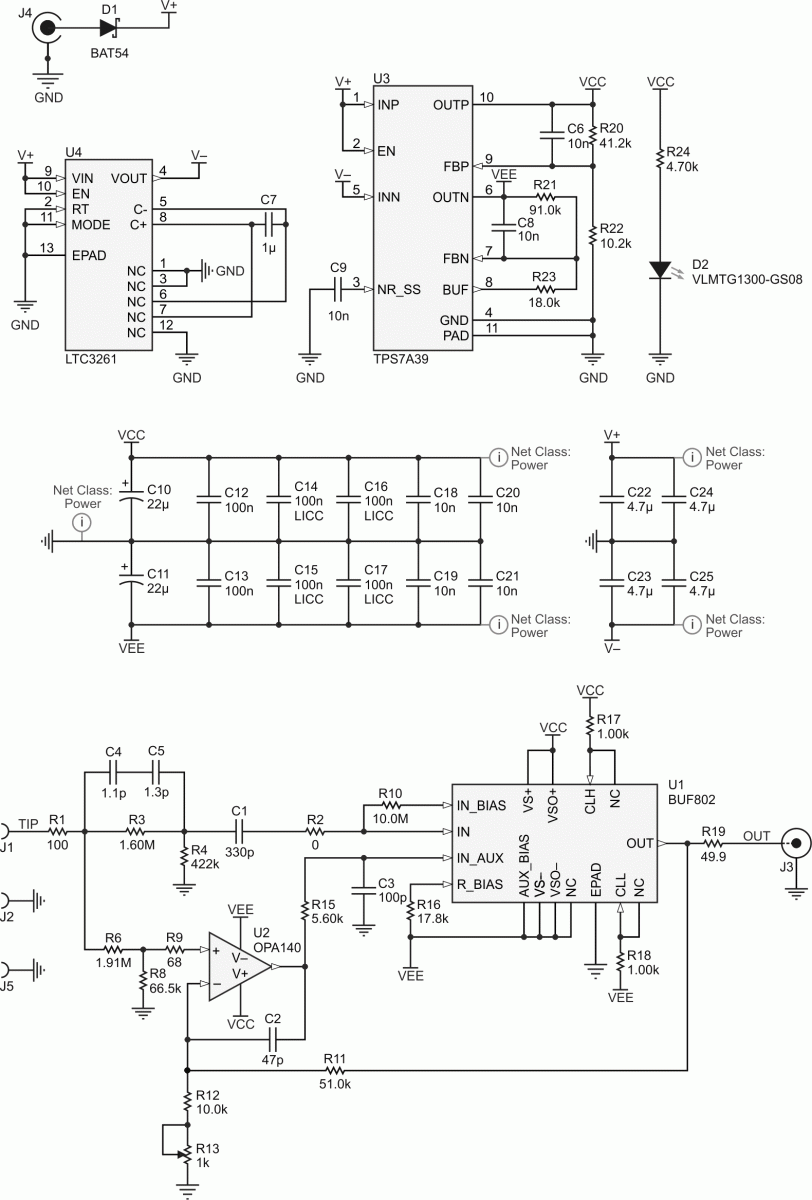 |
|
| Figure 14. | Complete schematic diagram of the probe. |
In a conventional composite loop, the low- and high-frequency paths are combined with a resistor-capacitor network at the input node of the buffer. The BUF802 offers internal combination that provides better isolation between the signal paths (Ref. 7). Without the pole from the R-C network in its output path, the op amp’s phase margin and closed loop bandwidth are improved, and the crossover frequency shifts higher. Since this circuit isn’t exactly equivalent to the conventional composite loop, I’ve opted to show the BUF802 as a “two-input buffer” in the basic schematic.
In the input network, the tip resistor R1 sets the probe’s minimum input impedance and damps the resonance imposed by the probe’s input capacitance and the ground lead inductance. It is critical this resistor is placed as close as possible to the probe tip. An additional damping resistor R2 allows fine tuning of the probe’s bandwidth and peaking response. In the most recent board revision, I found this to have no benefit and fitted a jumper in its place, and I may remove it entirely from the design in the future.
The main signal path uses a frequency compensated voltage divider. Like in a passive probe, this circuit has useful properties: the transfer function is flat at all frequencies, and the capacitance of the BUF802 is isolated from the input in proportion to the divider attenuation. A 1.6 MΩ and 400 kΩ divider provides 5× attenuation, and another 2× comes from the doubly-terminated output to yield the target 10× attenuation. Increasing R3 to 422 kΩ compensates for the slightly less-than-unity gain of the BUF802 and improves crossover region flatness. The BUF802’s input capacitance is 2.4 pF, so the required compensation for a 5× divider is 2.4 pF/4 = 0.6 pF. In the probe board, using two capacitors in series allows for easier tuning of the output level. I found a combination of 1.1 pF and 1.3 pF delivered almost exactly –20 dB at 100 MHz. Trimmer capacitors are also an option, but they are physically large and have worse parasitics. In earlier revisions, I used the PCB itself with a parallel-plate capacitor between layers 1 and 2 on the board. This amount of capacitance requires only a small area of copper, and the top layer can be trimmed off with a hobby knife to obtain the desired attenuation. However, I found this to be frustrating (once you remove copper, it’s gone!) and aspects of the probe’s performance demonstrated the PCB dielectric was much lossier than the datasheet led me to believe.
The signal path to the precision amplifier does not use compensation. A flat input characteristic is not needed here since this signal path is only used at low frequencies, and it is better to isolate as much of the op amp’s input capacitance as possible. The trace to get from the tip to the op amp is long enough to be considered a transmission line, so the probe board has a series termination resistor at the noninverting input (not shown). An R-C filter between the op amp and auxiliary input of the BUF802 attenuates signal and noise above the amplifier’s useful bandwidth. Circuit simulation shows the OPA140 runs out of closed-loop bandwidth around 30 kHz, so a 5.6 kΩ + 100 pF filter will set a corner frequency one decade higher.
The resistor values for the alpha and beta networks were chosen after some iterative trial and error subject to several constraints:
- The resistance looking into the alpha network needs to be 2 MΩ to make the parallel resistance of both signal paths equal to 1 MΩ.
- The gain of the amplifier must match the main signal path gain of 1/5. The variable resistor Rβ1 is realized with a 10 kΩ resistor in series with a 1 kΩ trimpot.
- To compensate for the op amp’s input capacitance, a feedback capacitor is added to make the poles and zeros of the system gain cancel out; the required capacitance is given by
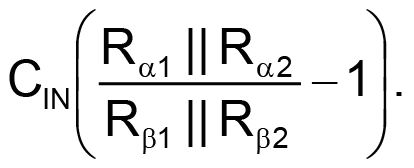
- The input resistance of the beta network needs to be high enough not to disturb the 50 Ω output impedance. Rβ2 should be placed as close as possible to the BUF802 output to prevent signal reflections.
In most high-frequency circuit design, the ground plane is your friend: it makes the impedance of traces well-defined and protects the circuit from both radiating and receiving noise. Here, it is not helpful because it adds shunt capacitance from the pads and traces of the input network, so the ground plane is voided underneath the components from the tip to the BUF802 input pin.
The power supply combines a LTC3261 charge pump to create a negative voltage rail, followed by a TPS7A39 dual positive and negative LDO. The BUF802’s bipolar output stage is quite thirsty and consumes nearly 40 mA of idle current, so some classic charge pump ICs like the 7660 are inadequate unless paralleled. The LTC3261 has a wider input voltage range, and can source 100 mA of current, making it a good single-chip solution.
A charge pump is a type of switching converter that uses only capacitors, and it tends to suffer from high output voltage ripple. The other board blocks need a high power supply rejection ratio (PSRR) to prevent the voltage ripple from coupling to the amplifier output. A back-of-the-envelope estimate for the peak-to-peak voltage ripple in the charge pump output is
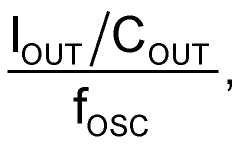
or about 5 mV.
Together with the negative-side PSRR figures of 50 dB (TPS7A39) and 40 dB (BUF802) from their respective datasheets, this is about 1 µV when referred to the probe input.
This is well below the expected voltage noise of the BUF802 across 2 GHz of bandwidth.
Simulation
The use of simulation tools was critical to the design of the probe, and even then, I had to do multiple board spins to get things right. Circuit simulation (LTspice) was used to design the precision amplifier loop, both in selecting input network components and doing stability analysis of the loop. LTspice’s capability to simulate arbitrary Laplace transfer functions was also useful in testing my hypothesis around PCB dielectric loss.
The input network parasitics are particularly difficult to think about without simulation; there is no ground plane, and a lot of irregular geometry that will vary in real use. To characterize this transmission line based on physical geometry, a field solver is needed, and openEMS is one of the few free and open source solvers available (Figure 15). The openEMS simulation output is a Touchstone file, which is then converted to a SPICE subcircuit using s2spice. This can used in a SPICE simulation as a “black box” component replacing the input network. After testing many candidate layouts for the input network in openEMS, I was more confident the design could achieve the goals for input capacitance. The simulated and measured input capacitance show reasonable agreement, with differences attributable to simplistic modeling of the ground lead inductance.
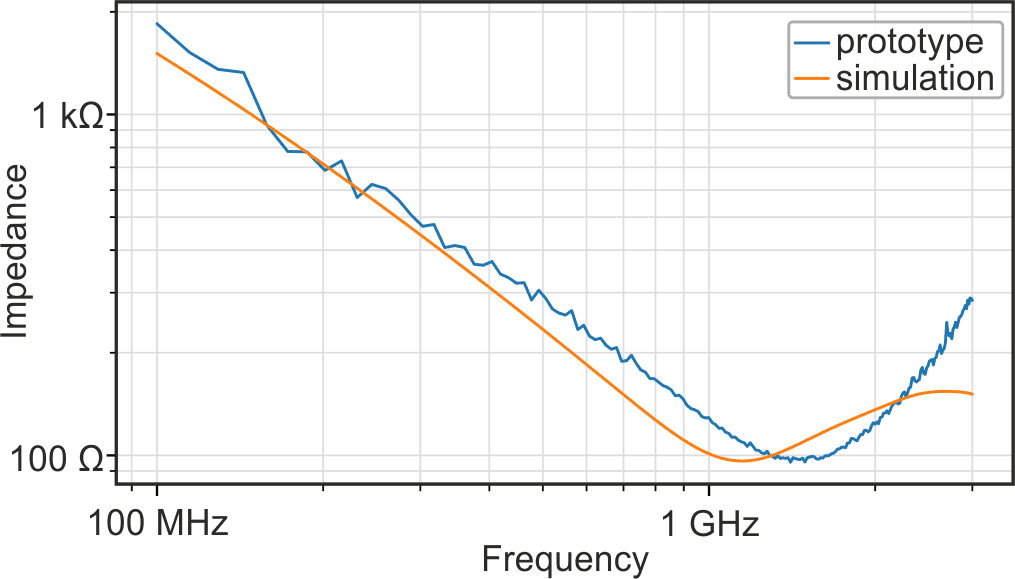 |
|
| Figure 15. | openEMS simulation of the input impedance compared to prototype measurement. |
openEMS was also used to match the output transmission line. OSH Park doesn’t offer a controlled impedance service, so you’re on your own for choosing a trace width to get a 50 Ω line. The trace thickness (1.7 mil) is significant compared to the dielectric (8 mil), and a field solver produces more accurate results than simple calculators when combining thick metal and coplanar waveguide lines (Figure 16). Tuning microstrip and coplanar waveguide lines is a great introduction to openEMS since the geometry is easy to express in code, and it’s very reuseable between projects.
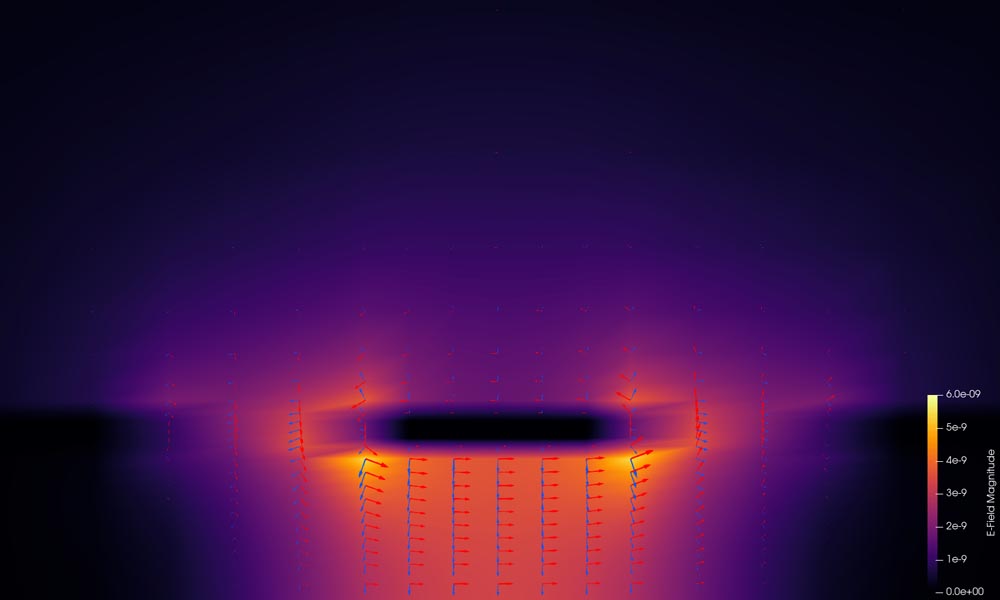 |
|
| Figure 16. | openEMS simulation of the input impedance compared to prototype measurement. |
References
- J. R. Kobbe and W. J. Polits. “Electrical probe,” U.S. Patent 2883619.
- ThunderScope
- 4 Layer Prototype Service
- Agilent Technologies. Side-by-Side Comparison of Agilent and Tektronix Probing Measurements on High-Speed Signals, Application Note 1491, January 2007.
- Tektronix. Probe Bandwidth Calculations, Technical Brief 60W-18324-0, November 2004.
- Keysight Technologies. Improving Usability and Performance in High-Bandwidth Active Oscilloscope Probes, Application Note 5988-8005, July 2014.
- Texas Instruments, Achieving high-DC Precision and Wide Large Signal Bandwidth with Hi-Z Buffers, Technical Article SSZT102, Jan. 2022.
Materials on the topic
- Datasheet Analog Devices ADA4625
- Datasheet Texas Instruments BUF802
- Datasheet Linear Technology LTC3261
- Datasheet Texas Instruments OPA140
- Datasheet Texas Instruments TPS7A39
- Datasheet Diodes BAT54
- Datasheet Vishay VLMTG1300